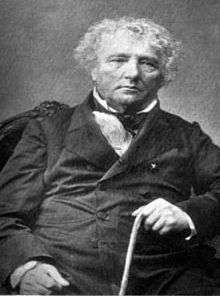Charles Bianconi
Charles Bianconi (24 September 1786 – 22 September 1875) was an Italo-Irish entrepreneur.
Charles Bianconi | |
|---|---|
 | |
| Born | 24 September 1786 Tregolo, Costa Masnaga (near Como), Italy |
| Died | 22 September 1875 (aged 88) Longfield House, Boherlahan, County Tipperary, Ireland |
| Spouse(s) | Eliza Hayes |
Life and work
Born Carlo Bianconi, Costa Masnaga, Italy on 24 September 1786, he moved from an area poised to fall to Napoleon and travelled to Ireland in 1802, via England, just four years after the 1798 rebellion. At the time, British fear of continental invasion resulted in an acute sense of insecurity and additional restrictions on the admission of foreigners. He was christened Carlo but anglicised his name to Charles when he arrived in Ireland in 1802.
He worked as an engraver and printseller in Dublin, near Essex Street, under his sponsor, Andrea Faroni, when he was 16. In 1806 he set up an engraving and print shop in Carrick-on-Suir, moving to Clonmel in 1815.
He eventually became famous for his innovations in transport and was twice mayor of Clonmel, in County Tipperary.[1]
Although widely regarded as the founder of public transportation in Ireland, he built on the system of mail coaches and roads that were built around Ireland before 1790 by the Scottish entrepreneur, John Anderson of Fermoy. After the collapse of Anderson's mail coach and banking empire in 1815, Bianconi established regular horse-drawn carriage services on various routes from about 1815 onwards. These were known as 'Bianconi coaches' and the first service, Clonmel to Cahir, took five to eight hours by boat but only two hours by Bianconi’s carriage. Travel on a ‘Bian’ cost one penny farthing a mile.
There were also a series of inns, the Bianconi Inns, some of which still exist; in Piltown, County Kilkenny and Killorglin, County Kerry.
These services continued into the 1850s and later, by which time there were a number of railway services in the country. The Bianconi coaches continued to be well-patronised, by offering connections from various termini, one of the first and few examples of an integrated transport system in Ireland. By 1865 Bianconi’s annual income was about £35,000.
Bianconi died on 22 September 1875 at Longfield House, Boherlahan, County Tipperary.
Having donated land to the parish of Boherlahan for the construction of a parish church, Bianconi wished to be buried on the Church grounds. He, and his family, are buried in a side chapel, separate from the parish church in Boherlahan, approximately 5 miles from Cashel, Co. Tipperary.
Family
In 1832 Bianconi married Eliza Hayes, the daughter of a wealthy Dublin stockbroker. They had three children - Charles Thomas Bianconi, Catherine Henrietta Bianconi and Mary Anne Bianconi[2] the wife of Morgan John O'Connell and mother of John O'Connell Bianconi.
See also
- Transportation in Ireland
Notes
- Espinasse 1885.
- The Michael O'Donohoe Memorial Heritage Project, Charles Bianconi , http://www.odonohoearchive.com/charles-bianconi/ |access-date=22/12/2018
References
- Espinasse, Francis (1885). . In Stephen, Leslie (ed.). Dictionary of National Biography. 4. London: Smith, Elder & Co.CS1 maint: ref=harv (link)
- Bianconi, M. O'Connell and Sydney John Watson, Bianconi: King of the Irish Roads, A. Figgs, 1962
- Mrs. Morgan John O'Connell (1878). Charles Bianconi: A Biography, 1786-1875. Chapman and Hall.
- Samuel Smiles (1890). "Charles Bianconi: A Lesson on Self-help in Ireland". Men of Invention and Industry. J. Murray. pp. 220–255.
- Thomas Joseph Ryan, Bianconi: A Boy with a Dream: The Pioneer of Irish Transport, Ryan Publications, 2007, ISBN 9780955504600
- Un lombardo in Irlanda breve storia di Samuele Smiles Milano tip e libr editr Giacomo Agnelli 1875
External links
- Tourism - Charles Bianconi
- Bianconi bio and photos of his native town
- Timetable 'Bianconi's Royal Mail Day Cars' from Leigh's New Pocket Road-book of Ireland, 1835.
- - Charles Bianconi and the ‘Ryanair of the 19th century.